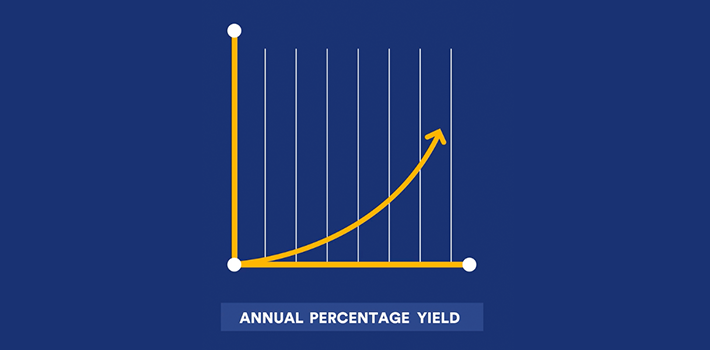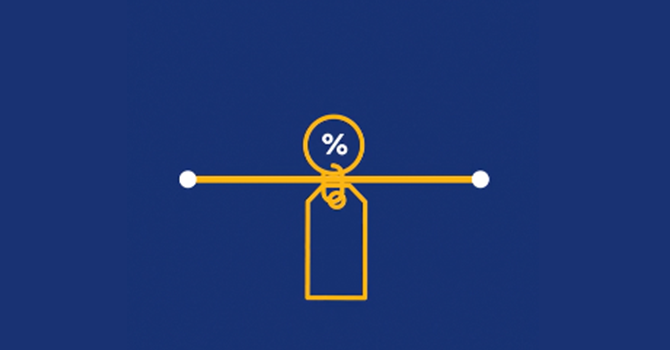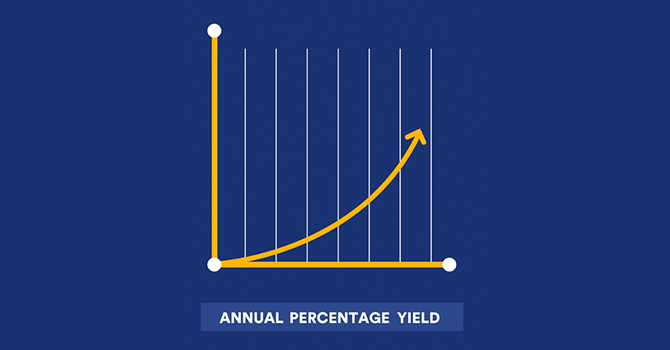APR vs APY: What’s the Difference?
Learn the difference between annual percentage rate (APR) and annual percentage yield (APY) and why it matters.


If you’re shopping around for credit cards, mortgages, student loan refinancing, or other financial products, you’ve likely seen the terms APR and APY used to describe annual earnings and costs. So, what is the difference between APR and APY? APR, or Annual Percentage Rate, represents interest owed. APY, or Annual Percentage Yield, denotes interest earned.
APR vs APY: What’s the difference in terms of interest rates?
Both APR and APY will incorporate a given financial product’s interest rate, but they each take different factors into consideration. APR can include additional fees, while APY includes compound interest. Compared to simply looking at interest rates, looking at both APR and APY could be more accurate representations of how interest grows.
You’ll typically find APR used to describe how much interest you’ll owe (as with a credit card or mortgage) and APY used to indicate how much interest you’ll earn (as with IRAs, CDs, or savings accounts).
Are APR and APY calculated differently?
Both APR and APY represent how financial products grow over time, and they’re calculated similarly. APR includes interest but also takes additional fees into account. The formula used to calculate APR is:
APR = (fees + interest per period) x Number of periods in a year
For example, if you carried a $100 balance on a credit card with a 17.99% APR, you would owe a total of $117.99 at the end of the year. You can also use this formula to calculate your interest rate from the APR; on that same card, your daily interest rate would be around .0493%, 1/365th of your 17.99% APR.
Credit cards gain interest daily, but different products accumulate interest at different rates. This rate can have a noticeable impact on your total interest, which brings us to a flaw in the APR: it doesn’t account for how interest accumulates its own interest (known as compound interest). That’s why we have APY, or Annual Percentage Yield. You’ll sometimes hear it referred to as EAR, or Effective Annual Rate. APY measures the earnings from investment, including compound interest.
Finance 101 Video
What is an APY?
Watch to learn about annual percentage yield (APY), which measures the amount you’ll earn over 12 months on an investment that pays compound interest – the higher your APY, and the more you could earn.
Watch MoreHow compound interest works with APR vs APY
APY expresses the annual rate of return while taking compound interest—which includes accumulated interest added to the principal—into account. If you want to quickly find out the compound interest you’d pay, you can use an APR vs APY calculator. If you prefer to work out the math yourself, the formula for calculating compounding interest and APY is:
APY= [1+(interest/number of compounding periods)]Number of compounding periods – 1
Say you used that 17.99% APR credit card from earlier to borrow $1,000. Going by the APR, you’d ostensibly owe $1,179.90 after a year. But if you use the formula to calculate the APY:
[1+(.1799/12)]^12 -1 = .1955, or 19.55%
You can see that you’d be on the hook for $1,195.50—that’s $15.60 more than the APR. The same financial product with the same interest rate can have a higher APY vs APR. The interest is accumulating interest of its own, growing the principal with every passing period. It might seem like a small amount of additional money, but it grows over time.
We used a credit card here to illustrate how figuring out a financial product’s APY can help you more accurately predict how your interest will accumulate. In most cases, however, you’ll see APY used for investments and savings accounts where you earn interest.
You might notice in the formula that the number of compounding periods will change how much total interest you’re making. At equal interest rates, an investment that compounds daily will earn more interest over time than one that compounds interest annually. As you shop around for financial products, you’ll want to look at interest rates and at how often you earn that interest.
How to use APR vs APY to make financial decisions
Now that you know what APR and APY represent, you can use them to decide between financial products. Remember that APR is typically used for products that involve borrowing, such as credit cards, and APY is usually used for investing, such as high-yield savings accounts or certificates of deposits (CDs). If you want to compare loans, bonds, or two of any kind of financial product, you need to make sure you’re converting them to the same metric for comparison.
When comparing financial products, remember that the gap between a product’s APR and interest rate can tell you a lot about where your costs will come from, as the APR counts fees while simple interest rates do not. The higher the APR relative to the interest rate, the more you pay in fees. And credit card providers could charge you a different rate depending on what you use the card for. For example, a cash advance typically has a higher APR than a regular purchase.
Finally, pay close attention to how often your interest compounds, particularly if you’re comparing APRs between two products. If you convert them both to APY, you’ll be able to determine which one has the better rate, given compounding interest.
Certain financial decisions may involve specific considerations when it comes to APR vs APY.
Finance 101 Video
What is an APR?
Watch to learn about annual percentage rate (APR), the total annual cost you pay to take out a loan or line of credit. For credit cards, personal loans, and/or a mortgage – your APR is the total interest owed over the course of a year, plus any other lender charges, such as points and fees.
Watch MoreAPR for student loan refinancing
When you refinance, you pay off debt from your old loan using a new loan with terms that are preferable to you. Student loan refinancing is no different, but you should keep a few things in mind. First, note that if you took out federal loans, refinancing could mean losing access to benefits like income-driven repayment plans or student loan forgiveness programs. Learn more at studentaid.gov.
When shopping around for a loan that has terms you prefer, you may want to consider whether a fixed or variable APR works for your situation. Also keep in mind that your credit score and debt-to-income ratio will likely be major factors in which loan terms you can secure.
If refinancing is the right move for you, be sure to shop around for the lowest rate on a repayment timeframe that works for you. By comparing APR rates and fees between lenders, you could find the best deal for you and minimize what you’ll pay in interest.
APR for mortgages
Mortgages almost always have additional costs, which makes APR a great metric for comparing them. If you just looked at the interest rate and APY, you’d risk being surprised by expenses like origination fees and closing costs—APR tends to give you a more accurate picture of what you’ll actually pay.
APR may be the most precise metric for comparing mortgages, but you might still want to look at APR vs APY to figure out how much compounding interest you’ll pay over time—particularly when looking at 20- and 30-year mortgages.
APY for high-yield savings
While compounding interest on debt such as a mortgage or student loan means more cost to you, earning interest on money you put into a savings account works in your favor. A high-yield savings account is a type of federally-insured banking product with an APY that’s higher than the national average. Earning more interest with a higher APY could help you reach your savings goals faster. Many banks and credit unions offer high-yield savings account products with competitive APYs, but some have a minimum balance requirement or may include monthly maintenance or other fees, so be sure to read the fine print to understand if this type of savings account is the right option for you.
The takeaway
Understanding the difference between APR and APY grants you a more holistic awareness of how interest will accumulate. If it seems like a lot to take in, just remember that APR usually refers to interest owed, and APY refers to interest paid. If you’re interested in learning more, Laurel Road has additional financial resources to help you figure it out.
This information provided is for informational purposes only and does not substitute consultation with a legal, tax or investment professional for important financial decisions. Laurel Road assumes no liability for loss or damage incurred by use of the information provided. Please visit laurelroad.com for full product details, terms and conditions.
All Laurel Road lending products are subject to credit approval.
In providing this information, neither Laurel Road or KeyBank nor its affiliates are acting as your agent or is offering any tax, financial, accounting, or legal advice.
Any third-party linked content is provided for informational purposes and should not be viewed as an endorsement by Laurel Road or KeyBank of any third-party product or service mentioned. Laurel Road’s Online Privacy Statement does not apply to third-party linked websites and you should consult the privacy disclosures of each site you visit for further information.
Don’t miss the latest financial resources.
This site is protected by reCAPTCHA and the Google Privacy Policy and Terms of Service apply.
Get tailored Laurel Road resources delivered to your inbox.
Search Results





